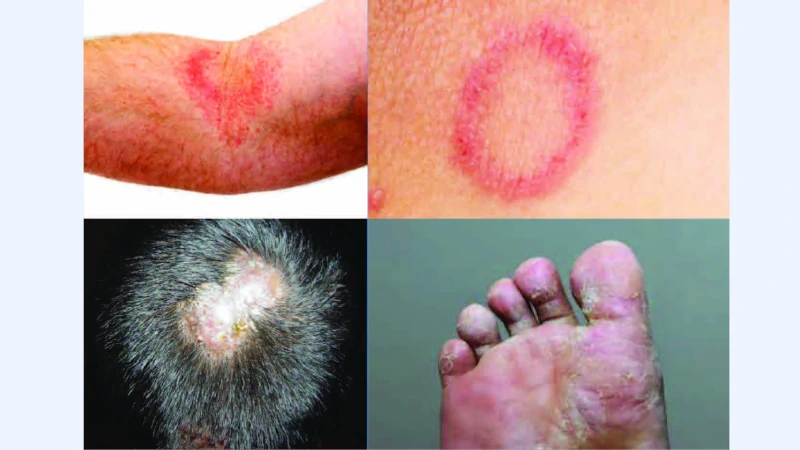
Treatment for Superfecial Fungal Infection in Bangalore
Fungi are large group of microscopic organisms present everywhere like soil, plants, decaying organic material etc. When these gain entry into the skin through macerated skin, scratches, cuts or injuries , they cause fungal infections on skin . Fungi thrive in warm, moist environments, hence we usually see fungal infections in the sweaty and damp areas like feet, groin and folds of skin.
Risk factors - Hot and Humid environment, excessive sweating, no proper hygiene, prolonged skin to skin contact, sharing of clothes, towels, shoes etc, through infected animals or plants via cuts or wounds, poor immunity due to uncontrolled diabetes , HIV , immunosuppressant drugs etc.
Causative organisms - Mainly classified into
- Dermatophytes - Microsporum, Epidermophyton, Trichophyton.
- Non dermatophytes - Candida, Aspergillus species, Fusarium species, Malassezia furfur.
Types of Fungal Infections
Ring worm or Tinea infection
Ringworm is caused by Dermatophytes. These fungi have affinity for Keratin tissue, a protein found in skin, hair, and nails. They do not invade beyond the dermis.
It’s called “ringworm” because it can cause a circular rash (shaped like a ring) that is usually red and itchy. Pool areas, locker rooms, public showers, and other areas prone to dampness are prime locations to pick up a fungal skin infection.
Depending on the site of infection, they are classified as -
- Tinea Capitis - Infection of hair and scalp
- Tinea barbae - Infection of beard & moustache area of face seen in adult males.
- Tinea Corporis - Infection of glaborous skin (skin without hair) excluding palms, soles and groin area.
- Tinea cruris - Infection of the groin.
- Tinea pedis or Athlete's foot - Infection of the feet
- Tinea Manuum - Infection of skin of the palm.
- Tinea unguium - Infection of nail.
- Tinea faciei - Infection of non beard areas of face , seen more often in pre pubertal boys and women.
- Tinea incognito - Tinea infection which is modified by topical or systemic steroid.
The above classification based on the site of fungal infection is important, since the strain of fungi affecting the different location are different and hence the management varies.
Majocchi's granuloma
As mentioned earlier, the dermatophytes do not invade beyond the epidermis (superficial layer of skin). But in some conditions, mechanical breakage of skin due to scratching or trauma and poor immune system can lead to penetration of the Dermatophyte fungi into dermis ( Deeper layer of skin) leading to Majocchi's granulomas.
Commonly seen in women who repeatedly shave their legs. Lesions appear as non itchy, single or multiple nodule like structures. Also few pus filled lesions might be present along with distinct reddish brown patches.
Candidiasis
Candidiasis is an infection caused by yeast Candida Albicans. this is a colonizer seen on the skin near body orifices, fingers, moist intertriginous areas. The host factors which contribute to invasion and infection are extremes of age ( too young & too old people), local tissue damage , maceration of skin, poor immune status (like in HIV, malignant patients etc) , severe uncontrolled diabetes, people who are on oral steroids for too long duration etc.
Candida can affect the
- Skin - Cutaneous candidiasis
- Oral cavity - Oral candidiasis
- Nail folds - Candidial paronychia
- Genitalia - Vulvo vaginal candidiasis (women) Candidial balanoposthitis (men)
Intertrigo
Intertrigo is a superficial inflammatory dermatitis occurring on two closely opposed skin surfaces as a result of moisture, friction, and lack of ventilation.Most commonly intertrigo occurs in toes, in the armpits, in the groin area, on the underside of the belly or breasts, in the crease of the neck. In severe cases, intertrigo may cause a foul odor, and the skin may crack and bleed.
Pityriasis Versicolor
Superficial fungal infection of skin caused by Malassezia furfur. The organism normally resides on the skin of healthy individual. Humid environment leading to hyperhidrosis, malnutrition, diabetes mellitus, prolonged cortico steroid medications etc predispose the person to develop the infection.The condition is asymptomatic or mildly itchy with whitish or brown colored patches and scales seen on the body.
Commonly seen in women who repeatedly shave their legs. Lesions appear as non itchy, single or multiple nodule like structures. Also few pus filled lesions might be present along with distinct reddish brown patches.
Management of Fungal infections
The diagnosis of the condition is made with proper history and thorough physical examination of the lesion with a magnifier or dermatoscope.
Confirmation of the diagnosis and Identification of the organism causing infection is done by KOH examination , Culture of the organism, woods lamp examination, immunological tests and skin biopsy. Once the exact causitive organism is identified and specific targeted treatment can be provided with necessary antifungals ( topical and oral).
Doctors at 4 Senses Clinic take history patiently, examine the patient thoroughly and diagnose the condition with minimal and necessary investigations. After finding out the root cause of problem, they provide accurate treatment. The doctors also counsel on how to prevent further recurrences. If you are looking treatment for fungal infection, Get Doctors Appointment Call:6366494494
